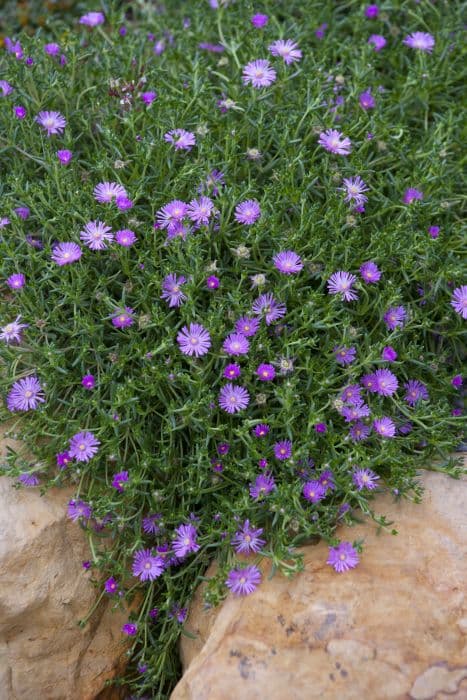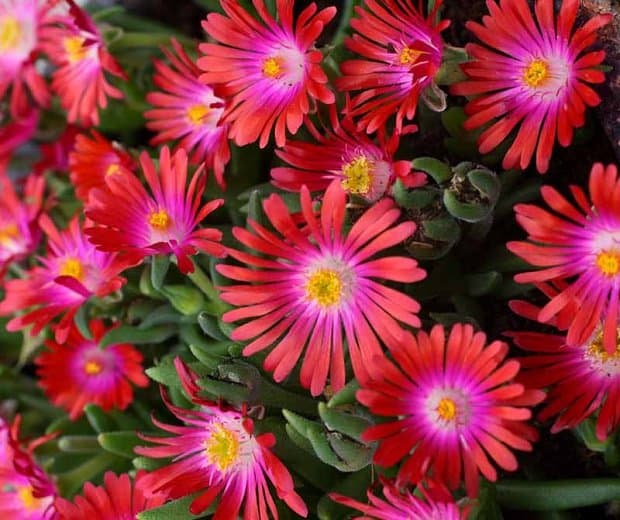Deltoid Leaved Dew Plant Oscularia deltoides

ABOUT
The common name of Oscularia deltoides is the deltoid-leaved dewplant. This succulent plant is characterized by its triangular-shaped, gray-green leaves that have small teeth-like projections on their edges, giving the appearance of a jaw lined with tiny teeth. These leaves are often tinged with pinkish hues, especially along the margins, adding to the plant's ornamental appeal. The deltoid-leaved dewplant produces striking flowers in profusion, commonly in shades of pink, with each flower composed of numerous thin petals radiating around a yellow to orange center. The flowers are known to attract pollinators such as bees, making the plant not only beautiful but also beneficial for the garden ecosystem. The deltoid-leaved dewplant has a sprawling habit, with its stems spreading out and taking root as they come into contact with the soil, allowing the plant to cover ground effectively.
About this plant
 Names
NamesFamily
Aizoaceae
Synonyms
Deltoid-leaved Dewplant, Pink Ice Plant, Sandsteenvygie
Common names
Lampranthus deltoides, Delosperma deltoides, Mesembryanthemum deltoides.
 Toxicity
ToxicityTo humans
Oscularia deltoides, commonly known as Deltoid-leaved Dewplant, is not widely recognized as a toxic plant to humans. There is limited information on its toxicity, and it is not typically associated with poisoning when touched or ingested. However, as with any plant, individual allergies or sensitivities can occur. If symptoms of an allergic reaction or ingestion associated illness are noted, medical attention should be sought.
To pets
Deltoid-leaved Dewplant is not commonly known to be toxic to pets. However, the same precautions that apply to humans regarding individual sensitivities should be considered for pets. If a pet ingests part of the plant and exhibits signs of distress such as vomiting, diarrhea, or unusual behavior, it is advised to consult a veterinarian.
 Characteristics
CharacteristicsLife cycle
Perennials
Foliage type
Evergreen
Color of leaves
Blue-green
Flower color
Pink
Height
1 feet (0.3 meters)
Spread
2 feet (0.6 meters)
Plant type
Succulent
Hardiness zones
9
Native area
South Africa
Benefits
 General Benefits
General Benefits- Drought resistance: Oscularia deltoides, commonly known as "Deltoid-leaved Dew Plant," is highly drought-tolerant, making it ideal for xeriscaped gardens.
- Ground cover: Its spreading habit and succulent leaves form an attractive ground cover that can withstand light foot traffic.
- Easy to propagate: The Deltoid-leaved Dew Plant can be easily propagated from cuttings, ensuring a quick and cost-effective way to expand your garden.
- Ornamental appeal: With its blue-green leaves and pink to purple flowers, this plant adds color and aesthetic value to rock gardens, coastal plantings, and alpine features.
- Low maintenance: Oscularia deltoides requires minimal care once established, making it an excellent choice for gardeners of all skill levels.
- Erosion control: The plant's dense mat-like growth can help prevent soil erosion in sloped and barren areas.
- Attracts pollinators: During flowering, the Deltoid-leaved Dew Plant is known to attract beneficial insects like bees and butterflies, promoting biodiversity.
- Salt-tolerant: It can thrive in coastal areas where salt spray would damage many other plants.
- Resilient to pests: Oscularia deltoides is generally resistant to many common garden pests, reducing the need for chemical interventions.
- Container gardening: Due to its compact size and attractive form, it's well-suited for container gardening and adding greenery to balconies or patios.
 Medical Properties
Medical PropertiesThis plant is not used for medical purposes.
 Air-purifying Qualities
Air-purifying QualitiesThis plant is not specifically known for air purifying qualities.
 Other Uses
Other Uses- Oscularia deltoides, commonly known as deltoid-leaved dewplant, can be used in miniature gardens due to its small size and attractive, succulent leaves.
- The deltoid-leaved dewplant can be utilized in rock gardens as it is drought-tolerant and adds texture with its plump, bluish leaves.
- This plant serves as a ground cover, spreading quickly to fill gaps and create a lush, carpeted effect in the garden.
- Deltoid-leaved dewplant can be cultivated as a living edge along pathways, where its tolerance to light foot traffic can be beneficial.
- The flowers of the deltoid-leaved dewplant can add a pop of color to green roofs, as they are adaptable to the shallow soils common in these installations.
- Due to its ability to cascade gracefully, Oscularia deltoides is ideal for growing in hanging baskets or over the edges of containers.
- Plant enthusiasts use this species in bonsai culture to create artistic representations of natural landscapes in miniature form.
- In coastal areas, deltoid-leaved dewplant can be employed to stabilize sandy slopes owing to its rooting system that helps reduce erosion.
- Photographers and filmmakers sometimes use deltoid-leaved dewplant as a set decoration to emulate exotic locations with its unique foliage.
- Lastly, children can learn about plant propagation using the deltoid-leaved dewplant due to its easy-to-root leaf cuttings, making it an educational tool in schools and homes.
Interesting Facts
 Feng Shui
Feng ShuiThe Oscularia deltoides is not used in Feng Shui practice.
 Zodiac Sign Compitability
Zodiac Sign CompitabilityThe Oscularia deltoides is not used in astrology practice.
 Plant Symbolism
Plant Symbolism- Resilience: Oscularia deltoides, commonly known as 'Deltoid-leaved Dewplant,' often grows in rocky and arid regions, symbolizing the ability to withstand tough conditions and adversity.
- Adaptability: With its succulent leaves that store water, the Deltoid-leaved Dewplant embodies adaptability and resourcefulness, thriving in environments where other plants might struggle.
- Beauty in Simplicity: The unassuming yet pretty flowers of the Deltoid-leaved Dewplant suggest that beauty can be found in the simplest of forms and does not need to be complex to be appreciated.
 Water
WaterThe common name for Oscularia deltoides is Deltoid-leaved Dewplant. This succulent should be watered deeply but infrequently, allowing the soil to completely dry out before watering again. Generally, during the growing season in spring and summer, water every 10 to 14 days, using about one to two ounces of water per inch of pot diameter each time. During the dormant season in fall and winter, reduce watering to once a month or less, depending on the humidity and temperature. Always avoid letting the plant sit in water as this can cause root rot.
 Light
LightThe Deltoid-leaved Dewplant thrives in bright, indirect light and can also tolerate full sun conditions. A south-facing or west-facing window would be an ideal spot for this plant. However, if you live in a very hot climate, provide afternoon shade to prevent sunburn.
 Temperature
TemperatureThe Deltoid-leaved Dewplant prefers temperatures between 50 and 75 degrees Fahrenheit but can survive in temperatures as low as 30 degrees and as high as 100 degrees Fahrenheit for short periods. The ideal range would be to keep it in a warmer environment during its growing season and cooler during dormancy.
 Pruning
PruningPruning the Deltoid-leaved Dewplant is necessary to maintain its shape and health. Trim back any dead or damaged parts as needed throughout the year. The best time for a more thorough pruning is at the beginning of the growing season in early spring. Pruning can also stimulate new growth, keeping the plant vibrant.
 Cleaning
CleaningAs needed
 Soil
SoilThe Pig's Ear plant benefits from a well-draining soil mix composed of equal parts potting soil, coarse sand, and perlite or pumice. It prefers a slightly acidic to neutral pH, ranging from 6.0 to 7.2.
 Repotting
RepottingPig's Ear should be repotted every two to three years to refresh the soil and accommodate root growth.
 Humidity & Misting
Humidity & MistingPig's Ear thrives in average room humidity conditions; it prefers not to be too humid.
 Suitable locations
Suitable locationsIndoor
Ensure bright light, well-draining soil, and minimal watering.
Outdoor
Place in bright light, protect from frost, and use gritty soil.
Hardiness zone
9-11 USDA
 Life cycle
Life cycleOscularia deltoides, also known as Deltoid-leaved Dewplant, begins its life cycle when seeds are dispersed, typically after flowering in spring or early summer. The seeds germinate given suitable conditions of warmth and moisture, and young seedlings establish themselves with their succulent leaves. The plant goes through a vegetative stage where it grows and spreads, forming a ground-covering mat due to its creeping stems. When mature, usually after a couple of years, the Deltoid-leaved Dewplant blooms, producing pink to purple flowers that attract pollinators. After pollination, the flowers develop into seed capsules, and once the seeds are mature, they are released to start a new cycle. This plant is also capable of vegetative reproduction through stem cuttings which can root and grow into new plants.
 Propogation
PropogationPropogation time
Spring-Early Summer
The most popular method of propagation for Oscularia deltoides, commonly known as Deltoid-leaved Dewplant or Pink Ice Plant, is through stem cuttings. You should ideally take cuttings during the plant's active growth period, which is usually in spring or early summer. To propagate, select a healthy-looking stem and cut a piece that is about 2 to 4 inches long (5 to 10 centimeters). Allow the cutting to callous over for a day or two to prevent rotting when planted. Once calloused, plant the cutting in a well-draining soil mix, barely covering the base with soil. Keep the soil moist but not waterlogged, and ensure the cutting is in a warm, well-lit area but out of direct sunlight to encourage rooting. Roots typically begin to form within a few weeks, and once established, the cutting can be treated as a mature plant.






![Ice plant [Fire Spinner]](/_next/image?url=https%3A%2F%2Fplants-admin.emdemapps.com%2Fimages%2Fplants%2F%2Fimages%2F604b54d98722a.png&w=640&q=75)


